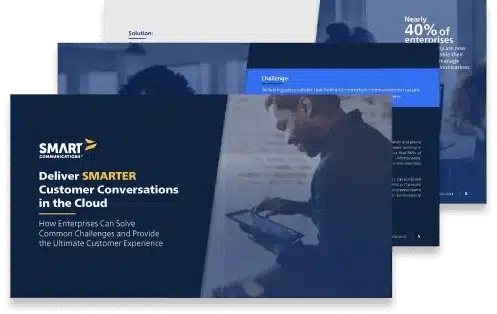SmartCOMM™ vs. Legacy Communication Systems: A Buyer’s Guide

By Smart Communications
When organizations evaluate customer communication systems/tools/software/technology, the decision often comes down to whether to maintain legacy systems or move to a modern, unified solution. Legacy tools may have been sufficient in the past, but today they can create complexity, higher costs, and slower response times.
In this blog, we compare legacy approaches with SmartCOMM, and outline the differences in efficiency, scalability, and compliance. The goal is to give you a clear, factual framework to support your CCM vendor evaluation.
What Is SmartCOMM?
SmartCOMM is an enterprise-level, cloud-based customer communications management (CCM) solution designed to streamline how organizations create, manage, and deliver communications. It replaces fragmented, multi-vendor setups with a single solution that supports both document generation and omnichannel delivery.
By integrating with existing systems, SmartCOMM helps ensure your customer communications are accurate, consistent, personalized, and compliant. It also adapts easily as business needs, customer expectations, and regulatory requirements evolve.
Why Legacy Communication Systems Fall Short
Legacy CCM systems typically rely on disconnected tools to handle print, email, SMS, and archiving. While workable, these setups often create hidden costs and operational inefficiencies that limit growth.
Other notable challenges with legacy CCM systems include:
- High IT overhead: Multiple contracts, upgrades, and maintenance cycles drain resources.
- Compliance gaps: Disconnected workflows increase the risk of errors and inconsistencies.
- Slow time-to-market: Making updates can take weeks or months due to siloed processes.
- Fragmented experiences: Customers receive communications and documents that lack consistency across channels.
SmartCOMM vs. Legacy CCM Systems: A Side-by-Side Comparison
|
Feature |
Legacy Systems |
SmartCOMM |
|
Inputs |
Manual data entry, limited integrations |
API-based; integrates with core business systems |
|
Outputs |
Print-heavy, siloed channels |
Omnichannel: email, SMS, portals, print |
|
Compliance |
Manual checks, higher error rates |
Centralized rules, automated compliance |
|
Scalability |
Difficult to adapt |
Cloud-based, scales with demand |
|
Time-to-Market |
Weeks or months |
Days or hours |
|
User Experience |
Inconsistent and fragmented |
Personalized, consistent, real-time |
Why Buyers Choose SmartCOMM
Consolidating wtih SmartCOMM has been shown to reduce costs, improve compliance, and deliver better communications. Keep reading to see how one of our customers did just that.
Case Study: Priority Health
Priority Health, a leading health insurer, modernized its communications infrastructure with SmartCOMM™. This transformation led to:
- 80% Reduction in Development Time: Streamlined claims and authorization processes, significantly cutting down the time required for development.
- Positive Return on Investment (ROI): Achieved a favorable ROI through enhanced operational efficiency and reduced costs.
- Eased IT Administrative Burden: Simplified IT management, allowing internal teams to focus on strategic initiatives rather than routine maintenance.
- Significant Reduction in External Vendor Costs: Lowered reliance on external vendors, leading to substantial cost savings.
Looking ahead, Priority Health plans to integrate more documents into SmartCOMM, collaborate with their marketing team for digital transformation, and utilize SmartIQ for enhanced interactive communication and data collection
To learn more, check out the video below:
See SmartCOMM in Action
Ready to compare for yourself? Schedule a demo and see how you can replace your legacy systems with a modern, unified communication platform. The best part? SmartCOMM demos take less than 30 minutes, are no obligation, and completely free!
Frequently Asked Questions
Q: What makes SmartCOMM different from legacy CCM systems?
SmartCOMM unifies communication and document generation in one system, while legacy systems rely on multiple disconnected tools.
Q: What formats does SmartCOMM support for input and output?
SmartCOMM integrates with core business systems using APIs, batch files, or real-time data feeds. On the output side, it supports true omnichannel delivery — including email, SMS, secure portals, and print — ensuring consistent and personalized customer experiences across all touchpoints.
Q: How difficult is it to migrate to SmartCOMM from a legacy system?
While any migration requires planning, SmartCOMM is designed to make the transition as smooth as possible. The platform offers flexible integration options, proven implementation methodologies, and expert support to guide teams through the process. Many organizations are able to phase the migration, starting with high-impact use cases and scaling over time. The result is a streamlined communications ecosystem with significantly lower long-term complexity and cost.
Q: How does SmartCOMM handle compliance?
SmartCOMM ensures compliance by centralizing rules and automating compliance checks, significantly reducing manual errors and associated risks. By consolidating your communications ecosystem onto a single cloud-based platform, organizations can improve internal efficiency and decrease reliance on IT teams. Regulatory language can be maintained and updated seamlessly across your entire communication portfolio from one place, ensuring consistency and accuracy. Built-in approval workflows, audit trails, and locked regulatory content blocks provide additional safeguards, giving teams confidence that all communications meet compliance standards while streamlining the review and approval process.
Q: Can SmartCOMM scale as my organization grows?
Yes. SmartCOMM is cloud-native and built to adapt to increasing volume and evolving needs.



